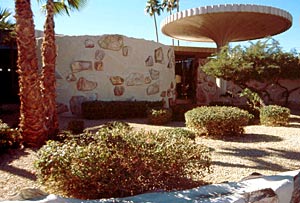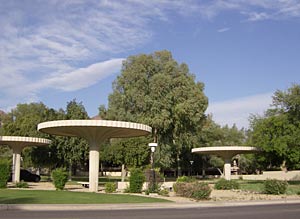If the fate of its mid-century bank buildings is any indication, Phoenix is withdrawing valuable architectural assets from its skyline to make way for growth in the nation’s sixth-largest city.

Designed by Weaver & Drover, now called DWL, in the 1960s, this Chase Bank in Phoenix's upscale Arcadia neighborhood, pays homage to Frank Lloyd Wright's architecture.

Photo: Courtesy City of Phoenix.
Frank M. Henry, the lead designer, hand-selected rocks for the bank’s walls.

Photo: Courtesy Roger Brevoort.
The bank’s 5-acre site also contains a public greenway, but developer Opus West is eyeing the site for a mixed-use complex.
Already lost are two celebrated neighborhood bank branches razed earlier this year: the Ed Varney-designed First Federal Savings branch, and the geodesic-dome Valley National Bank, in nearby Tempe, designed by Weaver & Drover, now called DWL. Dating to the early 1960s, they expressed Phoenix’s post-war commitment to regional architectural. In particular, the Valley National was the brainchild of longtime bank president Walter Bimson, an arts patron and friend of Frank Lloyd Wright. Even in a city where the automobile drove development, Bimson initially dismissed drive-up windows and preferred that customers meet with tellers face-to-face—he later came around.
Preservationists worry that another former Valley National branch, now occupied by Chase Bank, could be threatened. Located in the upscale Arcadia neighborhood, this 1967-vintage building is often mistaken for a work by Wright. The building’s precast mushroom columns, view windows, and the careful interweaving of modern materials with hand-selected local rocks are in fact Wright-inspired touches by Weaver & Drover project architect Frank M. Henry, who still teaches at Taliesin West.
The 4.7-acre Chase site includes the 9,000-squre-foot bank, a parking lot, and a greenbelt park that the last to buffer commercial and residential uses in Arcadia. But developer Opus West has proposed replacing the greenbelt and some of the parking lot with a complex of condominiums, restaurants, and retail space. “Our plans call for a design that is appropriate in today’s development market and preserves the bank branch,” says Jeff Roberts, the firm’s vice president of real estate development.
Neighbors and preservationists residents contend that even if the bank itself is spared destruction, its original contextual intent would be destroyed. “It would mean the loss of the last fragment of open space along Camelback Road,” says Arcadia resident Roger Brevoort. “The new building would intrude on the historic context and site of the bank, which was created and designed to be a combination of architecture, public art—and open space.”
For now, Opus West’s project awaits a hearing this summer before the 10-member Phoenix Planning Commission—a meeting at which the developer can bank on hearing from Brevoort and others.


Post a comment to this article
Report Abusive Comment